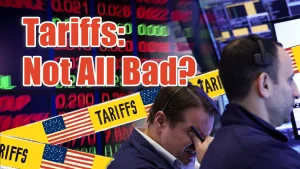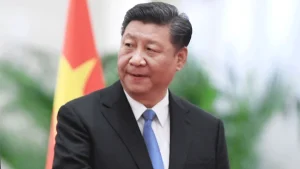Trump’s Tariff World War Will Kill the Dollar

On April 2, Donald Trump announced tariffs of at least 10% across all countries, with rates going even higher for 60 countries. CNBC reports goods imported from China now face a 54% tariff rate, CNN stating “China hit hard”.
However, China’s Xinhua News Agency called it “self-defeating bullying.” Chinese strategist, Professor Wang Xiangsui, pointed out two fundamental logical flaws of Trump’s new tariffs war that would accelerate the decline of the United States, and its dollar hegemony.
First, by imposing tariffs on the world, the world is essentially sanctioning the US
Besides China, Trump’s tariff plan also targets allies such as Australia, Japan, Canada and the European Union. However, nearly all countries have now introduced reciprocal tariff retaliation policies against the U.S. As a result, the U.S. is becoming the country most restricted by tariffs in global trade. Analysts and media worldwide have pointed out that Trump’s new tariff policy harms others without benefiting the U.S., causing severe disruptions to both the American and global economies.
Professor Wang believes that while Trump’s plan is highly destructive to the global economy, it offers almost no constructive solutions. This policy will tear apart the post-World War II global trade network, leading to the formation of multiple regional trade networks centered around major economies, with lower internal tariffs, competing against each other. In this new structure, China’s early-established multi-layered circulation economic system will demonstrate resilience and advantages.
 China’s former Finance Minister Lou Jiwei (L) gives a speech with the guests of the signing ceremony of the Asian Infrastructure Investment Bank at the Great Hall of the People in Beijing, 2014
China’s former Finance Minister Lou Jiwei (L) gives a speech with the guests of the signing ceremony of the Asian Infrastructure Investment Bank at the Great Hall of the People in Beijing, 2014
As early as 2013, China launched the Belt and Road Initiative. In 2020, China introduced the concept of a “dual circulation” economy. The “domestic circulation” refers to China’s vast domestic market of 1.4 billion people, ensuring that, regardless of global uncertainties, there are no internal tariff barriers or local protectionism between provinces and cities, allowing uniform policies for global investors, thereby providing maximum certainty in an uncertain world.
On the “external circulation” front, China maintains strong diplomatic and trade relations with Russia and ASEAN countries, linking a middle-tier trade network that encompasses one-fourth of the world’s population, characterized by complementary industries and lower internal tariffs. The BRI has further driven the development of the Global South. With a solid domestic circulation and a stable middle-tier circulation, China will have significant bargaining power when dealing with high-tariff trade networks in the U.S. and Europe.
China cannot prevent the U.S. from committing suicide, but after the current global trade order collapses, China—leveraging its strategic foresight and systemic advantages—will inevitably take the lead in reintegrating the fragmented regional trade networks.
Second, by sweeping new global tariffs, the U.S. will make the world less dependent on the dollar
Trump claims that raising tariffs will generate more fiscal revenue to address the $36 trillion debt crisis. However, his erratic tariff policies and aggressive stance towards allies have undermined the very foundation of the U.S. dollar—national credibility.
The U.S. dollar is the world’s reserve currency primarily because it dominates the settlement of commodities like oil, but more importantly, because of America’s strong national power compared to other countries, making its sovereign credit a global anchor. How much is U.S. credibility worth? When the Bretton Woods system was established, one ounce of gold was fixed at $35. However, as of April 2, 2025, gold has surged to over $3100 per ounce—suggesting that the dollar’s credibility has depreciated by 98%. Can a fiat currency with eroded credibility still serve as the world’s reserve currency? This is a question worth considering globally.
 Trump on Feb 22 said Elon Musk will be looking at Fort Knox, the legendary depository in Kentucky for American gold reserves, to make sure the gold is still there.
Trump on Feb 22 said Elon Musk will be looking at Fort Knox, the legendary depository in Kentucky for American gold reserves, to make sure the gold is still there.
Furthermore, the dollar-dominated global monetary system is increasingly disconnected from the real trade pattern. For example, in 2024, China accounted for approximately 19% of global GDP and 14.5% of global exports, yet the CNY’s share in global payments remains below 5%. However, Professor Wang also pointed out that while gold is a reliable benchmark for currency value, its inefficiencies in settlement and circulation make it unlikely to replace the dollar or restore a gold standard. Instead, digital currency may offer a new solution.
Unlike speculative cryptocurrencies such as Bitcoin and Ethereum promoted in the West, central bank digital currencies (CBDCs), represented by the E-CNY, are issued by sovereign central banks with substantial assets as backing. Professor Wang argues that CBDC can be anchored to a weighted index of a country’s minerals, food, energy, and industrial productivity, objectively reflecting each nation’s weight in global trade, thus fostering a fairer financial order.
Russia has successfully implemented commodity-backed currency policies. Following Western financial sanctions during the Ukraine War, the ruble-dollar exchange rate plummeted to a historic low in March 2022. In response, on April 1, 2022, Putin mandated that “unfriendly countries” purchase Russian oil and gas in rubles. Consequently, while energy prices in sanctioning European countries skyrocketed—leaving citizens struggling to afford heating—the ruble rebounded, appreciating nearly twofold by June 2022, surpassing its pre-conflict value by 30%. This demonstrated the superiority of currencies backed by tangible assets.

On the other hand, why China and Russia didn’t directly adopt cryptocurrencies like bitcoins? Venezuela has already proven the risks. The U.S. has long suppressed Venezuela, using financial tools to devalue its currency, plunging the world’s largest oil-rich country into artificial poverty. In 2018, Venezuela launched the Petro, an X11 algorithm-based design cryptocurrency backed by its oil reserves, attracting $3.3 billion in investments within its first month. However, in January 2024, a corruption scandal within its oil sector led to the project’s downfall.
In contrast, China has taken a stable and methodical approach to CBDCs. By late 2019, China began testing the E-CNY in several cities. Unlike Petro, the E-CNY is issued centrally by the People’s Bank of China, ensuring transparency, security, and seamless integration into the banking system. By July 2024, China had established E-CNY pilot programs in 26 cities, with 180 million users opening accounts and transactions reaching ¥7.3 trillion. The digital yuan has also been incorporated into Huawei’s HarmonyOS, enhancing its hardware-level security. Beyond China, other Global South nations are also exploring CBDCs. On January 12, the China Electronic Banking Network reported that Brazil’s Federal Bank had completed the first transaction using its CBDC, Drex. Major economies such as India and Russia have also launched their own CBDCs.

Professor Wang notes that as more Global South nations adopt CBDCs, these easily tradable digital currencies—backed by real-world resources and productivity—will decentralize monetary power and promote global financial equity. This shift will help resource-rich but historically exploited African and Latin American nations escape financial subjugation and gain the respect they deserve. In Chinese, the word “货币”(currency) consists of “货” (goods) and “币” (money). If resource-producing countries remain in monetary poverty, it only proves that the system is fundamentally distorted. Such a system is bound to be discarded by history.
Now, when US allies such as Australia criticize Trump’s decision as “not the act of a friend,” China—equipped with a longer-term economic vision, firmer strategic judgment, and stronger comprehensive national strength—has long recognized the irrationality of the US dollar hegemony. Through self-development, international cooperation, and technological innovation, China has devised a blueprint that is fairer, more inclusive, and more sustainable.
What renders Trump’s tariff policies ineffective is not only China’s economic strength but also a form of freedom and composure rooted in Chinese classical wisdom. Around 2,200 years ago, Zhuang Zhou proposed that true freedom is a state of non-reliance and non-expectation on others. If European and Canadian governments truly stand for their people’s interests and break free from dependence on the U.S., they can embark on an independent and long-term development path, ultimately attaining the same highest form of freedom as China. This is the most serious perspective worth considering amid Trump’s tariff drama. While Trump destroys the global free trade system with tariff weapons, China and BRICS nations are building new transnational trade frameworks. We firmly believe that global public opinion will side with the builders.
 Chinese President Xi Jinping and participants in the 2024 BRlCS Summit in Kazan, Russia.
Chinese President Xi Jinping and participants in the 2024 BRlCS Summit in Kazan, Russia.
Editor: Charriot Zhai
https://www.cnn.com/business/live-news/tariffs-trump-news-04-02-25/index.html
https://www.washingtonpost.com/business/2025/04/01/trump-tariffs-draft-recession-projection/
https://www.bbc.com/news/articles/c99pvll3ne3o
https://edition.cnn.com/2025/04/01/politics/trump-tariffs-liberation-day-oval-office/index.html






Anonymous
What Mr Trump is saying to the rest of the world is; our target is not you, our target is China. Join us in our tariff war against China, or you are against us. By “bringing manufacture back”, he does not mean back to the USA homeland, he means to the hinterlands, the vassal states, which the US can control.